Sardinia Travel Guide
DH Lawrence passed through Sardinia in 1921, remarking on its geographic location as a place 'lost between Europe and Africa and belonging nowhere'. By Italian standards, it's off the beaten track; but therein lies its appeal, with its beaches being some of the cleanest and least crowded in Italy.
The capital is Cagliari, a good base from which to explore other parts of the island. The National Archaeological Museum of Cagliari contains prehistoric tombs and other significant artefacts from the Punic and Roman periods. The resort of Costa Smeralda is a place of luxury and opulence, not suited to budget tourists but interesting for a brief stop.
The Spanish-flavoured port of Alghero is the favoured package destination, especially among British holidaymakers. The inland town of Nuoro is a good station from which to explore the Gennargentu mountain range and enjoy the traditional village festivals. The Sardinian landscape is peppered with constructions from the ancient Nuragic civilisation, the UNESCO-listed stone structures being unique to Sardinia and are must-see sites. However, they aren't easily accessible as they lie in isolated spots throughout the island.
Things to do in Sardinia
The second largest island in the Mediterranean sea, Sardinia is mainly touted for its lovely beaches and hiking trails and draws windsurfers and boaters to its shores in droves. The coastal regions can get very busy in the summer, especially August. Apart from the wonderful landscapes and outdoor activities, Sardinia offers the remnants of mysterious ancient settlements: the ancient Nuragic civilisation of Sardinia, which predates the mainland Etruscan civilisation by several centuries, left stone monuments dotting the island.
La Maddalena Archipelago National Park (Parco Nazionale dell'Arcipelago di La Maddalena) is an almost uninhabited group of islands in a protected marine area, attracting visitors with its natural splendour and pristine beaches. Other gorgeous beaches in Sardinia include Cala Mariolu and Cala Goloritze in Baunei, which are regularly lauded as the most beautiful beaches in Italy, and are a must for sun-seekers looking for the perfect Mediterranean setting. Costa Smeralda boasts the most glamorous beaches in Sardinia and attracts the jet-set with its luxurious villas and upmarket resorts. The city of Alghero, on the northwest coast, is also a tourist hub and has some great beaches.
Those interested in the ancient Nuragic inhabitants of Sardinia can explore the thousands of fortified circular structures still remaining on the island. The complex of Nuraghe in Barumini has been added to UNESCO's World Heritage List and is the finest and most complete example of this intriguing prehistoric architecture. Another interesting cultural diversion is provided by the home of Garibaldi, one of Italy's great revolutionary leaders, which has been turned into a museum. Cagliari, the capital of Sardinia, has some cultural treasures, most notably in the Citadel of Museums complex, which includes the National Archaeological Museum.
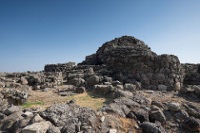
Cagliari
Cagliari is Sardinia's capital. The biggest city in the region and a busy industrial port, its old centre is charmingly compact and contained within the city walls and Pisan fortifications. The main attractions are the National Archaeological Museum, which contains prehistoric tombs and other significant artefacts from the Punic and Roman periods; the impressive cathedral; and a smattering of Roman ruins.
The suburb of Poetto has a four mile (6km) stretch of sandy beach with some small bars nearby. The famous archaeological site of Su Nuraxi near Barumini is also within easy reach of the town.
Sardinia's history and culture are found in the Citadel of Museums complex: the Archaeological Museum houses artefacts from all the ancient cultures of the island, such as ceramics from Phoenician tombs, Punic jewellery and Nuragic bronzes; the Picture Gallery boasts contemporary art and sculpture; the Siamese Museum exhibits fascinating items from the East; and the university houses sculptures by wax artist Clemente Susini.
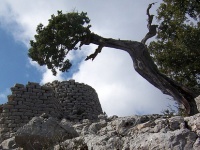
Nuraghe
Having arrived in Sardinia around 1500 BC, the mysterious Nuragic people festooned the island with about 30,000 circular fortified structures, of which 7,000 remain standing today. The complex of Nuraghe in Barumini has been added to UNESCO's World Heritage List and is the finest and most complete example of this prehistoric architecture. Other well-preserved Nuraghe can be seen at Sant Antine, while at Nora are the remains of an extensive Nuragic village including an amphitheatre, forum, baths, temple and kasbah. Other good Nuragic sites are near Villanovaforru, Alghero and Abbasanta. The purpose of the beehive-like buildings remains unknown but archaeologists assume they were used as religious temples, meeting halls and military strongholds.
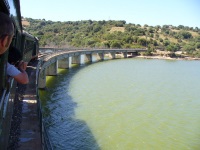
Trenino Verde
Sardinia has an unforgettable coastline, but the interior of the island is equally as beautiful. A fun way to explore it is aboard the Trenino Verde (Little Green Train), a vintage steam locomotive that puffs its way through forests, over bridges and through tunnels into some of the island's most scenic mountain areas. The train runs on scheduled routes, connecting Nuoro and Bosa, Sassari and Alghero, Sassari and Palau, and Cagliari and Arbatax. The train is small and tickets are limited so it's best to book in advance. The train sometimes stops at scenic spots so that passengers can stretch their legs and take photographs.
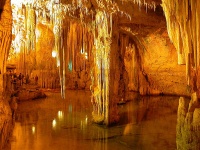
Neptune's Grotto (Grotta di Nettuno)
A popular sightseeing expedition from Alghero is a boat ride to Neptune's Grotto, an impressive deep marine cave at the bottom of the sheer cliffs of Capo Caccia. At the cave, visitors take a 45-minute tour entering through the long meandering passage delved into the rock to view dramatically-lit stalagmites and stalactites. The contrast of the sun sparkling bright on the sea and orange cliffs against the dark depths of the cave is truly magical. But the grotto can also be reached by bus from the main terminal in Alghero, or by car, which on arrival necessitates climbing down 650 steps to the cave entrance.
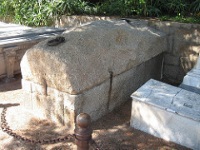
Garibaldi's House
The famous Italian general and politician Giuseppe Garibaldi lived the last third of his life on the woody, undeveloped island of Caprera. Considered a 'founding father' by Italians, he's famous for his military campaigns in South America and during Italy's unification period. The elegant homestead has been preserved as he left it and visitors can learn a lot about his lifestyle from exploring the farm; on Caprera he lived a simple, peaceful life tending his gardens and orchards. Tours of the property end with his tomb in the garden, as well as a relic room filled with some of his personal belongings and historical artefacts. For many Italians and foreign visitors Garibaldi's house and grave are a pilgrimage of sorts, a place to pay homage to a national hero.
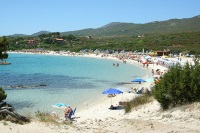
Costa Smeralda
The jet-set strip of Sardinia, Costa Smeralda is a six-mile (10km) stretch of coastline between the gulfs of Cugnana and Arzachena. The local villages and towns around Costa Smeralda have become discreet upmarket resorts, crammed with private villas, luxurious holiday villages and huge yachting marinas packed with gleaming vessels. The main town of the area is Porto Cervo, a playground of the rich and famous with its ranks of pale pink and red villas climbing the hill from the busy marina.
Another favourite retreat for celebrities is the town of Porto Rotondo, which offers a wealth of beaches, nightclubs and restaurants, most clustered around its Piazza San Marco and the marina. The main attractions are the many sequestered beaches, among the most scenic being Cappriccioli, Rena Bianca and Liscia Ruja.
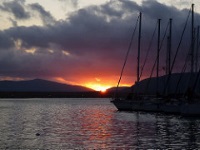
Alghero
The flourishing fishing port of Alghero is Sardinia's tourist centre, and consists of a picturesque and well-preserved old town enclosed in stout walls. Outside, the new town sports a grid of parallel streets, filled with hotels and restaurants. A favoured package tour destination, Alghero offers beautiful beaches, hotels and restaurants, together with numerous places of interest.
The narrow cobbled streets are lined with ornate churches, wrought-iron balconies and a number of boutiques and cafes, as well as the workshops of craftsmen working the famed coral of Alghero. The local cuisine has a taste of Spain, with Alghero renowned for its authentic Spanish paella, lobster Catalan and tasty fish soups, along with delicious sea urchin and aromatic wines.
The coast offers many secluded bays, small inlets bordered by pine forests and high, jagged cliffs. Nightlife is sedate, tending more toward sipping cocktails at a sidewalk cafe and watching the sunset.
Sardinia Climate and Weather
Sardinia has a typically Mediterranean climate, but the south is generally much drier than the northwestern region, which receives a lot of rain in winter. The wettest months are November and December, while July and August are the hottest and the driest, with an average temperature of around 95F (35C), sometimes reaching 104F (40C). In winter, temperatures average about 50F (10C) along the coast. Spring and early autumn are the best times to visit Sardinia.
Italy travel info
Electricity
Electrical current in Italy is 230 volts, 50Hz. A variety of plugs are in use, including the European-style two-pin plug.
Language
The official language of Italy is Italian. English is understood in the larger cities but not in the more remote parts of the country.
Money
The euro (EUR) is the official currency, which is divided into 100 cents. Those arriving in Italy with foreign currency can obtain euros through any bank, ATM or bureau de change. ATMs are widespread; credit cards are accepted in upmarket establishments and shops around the cities, although cash is expected when paying for items that are less than 10 euros. Banks are closed on weekends but tend to have better rates than foreign exchange houses.
Tipping
Tipping is customary in Italy and 10 to 15 percent of the bill is acceptable in restaurants, unless a 15 percent service charge has already been added to the bill. Hotels add a service charge of 15 to 18 percent, but it is customary to tip the service staff extra. Italians rarely tip taxi drivers but a 5 to 10 percent tip is always appreciated.
Health
There are no specific health risks associated with travel to Italy and visitors should be able to travel without special vaccinations and medications. Medical facilities in Italy are good but travel insurance is still recommended for non-EU citizens, as medical attention can be expensive. EU citizens can make use of Italy's health services provided they have a European Health Insurance Card (EHIC), with UK citizens using their Global Health Insurance Card (GHIC). The GHIC replaced the EHIC for UK citizens and allows UK citizens access to state healthcare during visits to the EU. The GHIC is not valid in Norway, Iceland, Liechtenstein or Switzerland, nor is it an alternative to travel insurance. Although it should be possible to get most medication in Italy, travel authorities always suggest taking any prescribed medication in its original packaging with a signed and dated letter from a doctor.
Safety
Tourists are vulnerable to pickpocketing in the bigger cities, particularly on public transport, in crowded areas and around tourist sites. It's advisable to be careful when carrying large amounts of cash and valuables. Travellers should be particularly careful around Termini, which is the main train station in Rome. Visitors should be wary of groups of children, some of whom will distract attention while the others try to steal what they can. Strikes by transport workers take place regularly throughout Italy and delays are possible.
Local customs
Italian are elegant dressers and travellers should opt for smart casual clothes if they want to fit in, particularly in Rome or Milan. Gym clothes should be kept for exercise, and shorts, vests or any other immodest clothing should not be worn inside churches. The pace of life is a little slower in Italy, so tourists should immerse themselves into the local rythym, and enjoy long lunch breaks, and casual coffee stops.
Doing business
Italians can be very formal and old fashioned, but are also warm and welcoming. Face to face communication is best and often a third party introduction can speed initial negotiations. Business attire is formal and stylish, and handshakes are the norm, with first impressions counting a lot in Italy. Business cards are used. Visiting business people should also expect plenty of gesticulating, interruptions or people talking over each other. Unfortunately the bureaucracy in Italy can slow down deal-making. Business hours are usually 9am to 5pm Monday to Friday, but can vary according to season and region.
Duty free
Travellers over 17 years from non-EU countries do not have to pay duty on 200 cigarettes, 50 cigars or 250g of tobacco. Nor do they have to pay duty on 4 litres of wine, 16 lires of beer or 1 litre of spirits over 22 percent volume, or 2 litres of alcoholic beverages less than 22 percent volume. Other goods up to the value of €430 are also permitted (reduced to €175 for children under 15).
Travellers from EU countries travelling within the EU are limited to 110 litres of beer, 90 litres of wine, 10 litres of fortified wine, 10 litres of spirits and 1kg of tobacco, 800 cigarettes, 200 cigars or 400 cigarellos. Prohibited items include narcotic drugs, medicinal products, arms and weapons, explosives and protected animal and plant species.
Communications
The international access code for Italy is +39. Hotels, cafes and restaurants offering free WiFi are widely available; as international roaming costs can be high, purchasing a local prepaid SIM card can be a cheaper option.
Passport & Visa
The borderless region known as the Schengen Area includes the following countries: Austria, Belgium, Czech Republic, Denmark, Estonia, Finland, France, Germany, Greece, Hungary, Iceland, Italy, Latvia, Lithuania, Luxembourg, Malta, The Netherlands, Norway, Poland, Portugal, Slovakia, Slovenia, Spain, Sweden and Switzerland. All these countries issue a standard Schengen visa that has a multiple entry option, and which allows the holder to travel freely within the borders of all the aforementioned countries. All foreign passengers to Italy must also hold visible proof of financial means to support themselves while in the country, return or onward tickets, and the necessary travel documentation for their next destination. Visitors may be refused entry, either for public security, tranquillity, order or health reasons. Extensions of stay in Italy are possible by applying to local authorities. It is highly recommended that travellers' passport have at least six months' validity remaining after the intended date of departure from their travel destination. Immigration officials often apply different rules to those stated by travel agents and official sources.
Entry requirements
US citizens must have a passport that is valid for at least three months beyond their intended stay in Italy (and issued within the last 10 years). No visa is required for stays of up to 90 days within a 180-day period.
UK citizens must have a passport that is valid for at least three months beyond their intended stay in Italy (and issued within the last 10 years). No visa is required for stays of up to 90 days within a 180-day period.
Canadian citizens must have a passport that is valid for at least three months beyond their intended stay in Italy (and issued within the last 10 years). No visa is required for stays of up to 90 days within a 180-day period.
Australian citizens must have a passport that is valid for at least three months beyond their intended stay in Italy (and issued within the last 10 years). No visa is required for stays of up to 90 days within a 180-day period.
South African citizens must have a passport that is valid for at least three months beyond their intended stay in Italy (and issued within the last 10 years), and a valid Schengen visa is required to enter Italy.
Irish citizens must have a passport that is valid for the duration of their stay in Italy. No visa is required.
New Zealand citizens must have a passport that is valid for at least three months beyond their intended stay in Italy (and issued within the last 10 years). No visa is required for stays of up to 90 days within a 180-day period.
Useful contacts
www.enit.it
112 (General Emergencies), 113 (Police), 118 (Ambulance)


